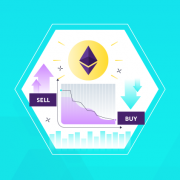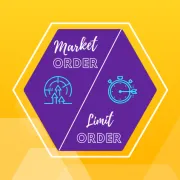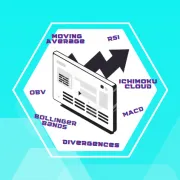Managing profits and losses when performing a trade is key, and beginner traders do not use tools such as Stop-Loss and Take-Profit. The following article will introduce the reasons why you should learn how to use Stop-Loss and Take-Profit as soon as possible, and share some advice for beginner traders.
Article summary
How to Manage Risk in Trading?
By far, the most important task of risk management is to preserve capital. You can make gains of 5,000% on your capital, but the loss will always be maxed out at 100%. And once you lose it, there is no way to make it back without funding the account again. Period. So when you manage risk properly, you are acting in your own best interest.
The type and way and style that you employ to concretely manage risk, vastly depends on what you are doing. But, it is also important to understand that risk in trading does not only come from having a position on.
There are other forms of risk for example:
- Operational risk in the form of an exchange going under, being seized over by the SEC, or simply getting hacked
- Systemic risk related to the stablecoin you might be using to trade
- Credit risk where, if you get too leveraged but do not have enough liquidity in the account, you might be margin called to forbid you from defaulting on the position
Trading related risks can be easily mitigated with Stop Losses or different mechanisms available in your exchange or trading platform. Systemic and Operational risks are harder to mitigate, but it can be done in the form of diversifying yourself by being on multiple exchanges, and trying to use as many different stable coins as you can.
What is a Stop-Loss Order?
A Stop-Loss order is an order that stops the position when a certain target is reached. This is probably one of the most important types of orders in your risk management toolbox.
It can either be used to close a losing position, or, as in the case of a trailing stop, it can be used to let a winner run, but protecting the made capital with the Trailing Stop.
How to set a Stop-Loss?
This depends on the trading platform you are using, as well as the exchange. Some exchanges don’t allow stop orders in the traditional sense. Here are the different ways to set a Stop-Loss while you trade crypto:
- If the platform supports then use it, but be mindful that these orders often take from the order book as it executes as a Market order. This will most of the times increase your fees.
- Some platforms offer ‘Reduce Only’ type of orders where you’d have to place an order on the opposite side with the same volume as your position, but with the reduce only flag. This flag is useful to make sure the order is executed only if the position is still open and it was not stopped/liquidated.
- In crypto futures trading, you have the possibility of using the ‘One Way Mode’ as opposed to the ‘Hedge Mode’. In ‘One Way Mode’ mode, if you set an order with the same size of your position, but in the opposite direction, when filled it will automatically close your existing position. If you want to have 2 different positions, one long on a bigger timeframe and another short on a smaller time frame, then you will use Hedge Mode.
Pros and Cons of Stop-Loss Orders
While a Stop-Loss can be a great way to protect your capital from taking massive hits, it comes with a big con. Essentially, and depending on how you set the location of the stop, this ‘protection’ can actually take you out of what would otherwise be a very profitable position.
As a matter of fact, Larry Connars argues that the use of a Stop-Loss is bad, and in his backtests, found that it does nothing but kill a winning position. Most of the statistics that we gathered inside Vestinda show that a small value for Stop-Loss is shrinking the returns.
However, you can use a bigger value for a Stop-Loss for peace of mind and for the moments when the market really goes south. In crypto, usually something around 10-12 percent is a good value. There could be a middle ground found in using DCA (Dollar Cost Averaging) in order to swim out of a loser. But, you need to be mindful that this could exponentially amplify your losses.
What is a trailing Stop-Loss?
A trailing Stop-Loss is not used to protect you from a loser, but rather to protect a winner from losing, when it gets past a certain level. Or to protect profits.
How to set a trailing Stop-Loss?
Nowadays, most if not all crypto brokers and exchanges do not offer an automatic trailing stop order. Traditional platforms like MT4 or cTrader might offer that feature if it is supported by the broker. But it often is limited in that it trails based on a change in pip in the direction of the position.
The best way to trail a stop depends on your strategy. First you need to define your targets. You can do it either with a simple formula or using an indicator such as the Average True Range, or Stochastic Indicator. Once the target is defined, you can either place the stop order manually, or use platforms that can do it algorithmically for you, such as Vestinda.
What is a Take-Profit Order?
A Take-Profit order is an order to take profit once a certain price level is reached. It allows you to lock in the unrealized profits, and it is essentially the order that closes the position in green.
How to set Take Profit?
Setting a Take-Profit is very similar to how you would set a Stop-Loss, as described above.
The one thing to note is that on some exchanges, you can actually get paid a rebate for placing such orders, because, unlike Stop-Loss orders that take from the books, Take-Profit orders actually put liquidity in the book. You’d essentially become a market maker, and crypto exchanges tend to reward that. Something that traditional markets rarely if ever, do.
What is a trailing Take-Profit?
A trailing Take-Profit is very similar to a trailing Stop-Loss, but it activates only after the price closes above the target set for the Take-Profit. In a way it is a trailing stop that is activating only after the price closes above the Take-Profit price.
How to set a trailing Take-Profit?
Native exchanges do not offer this kind of feature yet. But you can find it on platforms such as Vestinda that add up to your trading toolset.
To set a trailing Take-Profit in Vestinda you will use the Trailing Stop Multiple Levels feature. It helps you manage different levels of stop based on the price appreciation. You can set multiple levels of stop based on how much the position has gained. Format is “5/3, 10/4”. First number is the profit activation level and the second number is the stop percentage. With this example, if the price appreciated with 5% since the entry point, then the stop is activated and set at 3%. Then if the price reaches a 10% appreciation (closes 10% higher than the entry point), the stop is changed to 4%. The position will be closed when and if the price moves against you with the current stop value. So, if the price closes 10% above the entry point and then it decreases 4%, the position will be closed.
Pros and Cons of Take-Profit Orders
Take-Profit orders are great to help you lock in the profit and ensure that your hard earned patience is rewarded. Knowing how and where to set it is an important element in order to define Risk Reward Ratios that can, along with win rate, tell you how profitable or not your strategy is.
The downside of a Take-Profit order is that it could take you out of the market earlier than expected, leaving much of the future potential profits on the table. Trust us, there is nothing more frustrating than seeing a potential 10:1 Risk Reward Ratio position closed at a poor 1:1 due to a fixed take profit. To mitigate this, you can use a trailing Take-Profit with multiple levels instead if available in your platform.
All in all, trading can make you uncomfortable if you don’t use protective strategies. Using Stop-Loss and Take-Profit orders can create a reasonable comfort level and secure your investing experience.

Founder & CEO of Vestinda.
Compacting years of investment portfolio building into just a few minutes.






